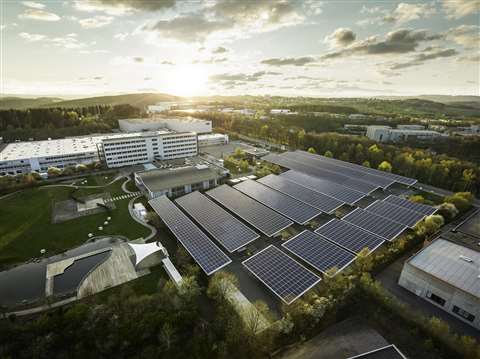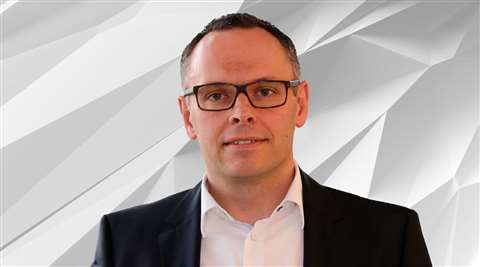How can technology help to decarbonise the built environment?
20 December 2022
Dr Thorsten Mueller of ABB Electrification’s Smart Buildings Division explains how digital and automation technologies – along with integrating renewable sources – are optimising energy consumption and reducing emissions in commercial and industrial buildings.
Limiting the rise in our global temperature to 1.5°C is one of humanity’s biggest challenges. Revolutionising industrial and commercial infrastructure will be critical in our efforts to reduce the emission of greenhouse gases (GHG) and digital technologies have a pivotal role to play.
 ABB flagship in Lüdenscheid (Photo: ABB)
ABB flagship in Lüdenscheid (Photo: ABB)
According to the International Energy Agency (IEA), the buildings and building construction sectors combined are responsible for almost one-third of total global final energy consumption, and nearly 15% of direct CO2 emissions1.
As our cities become more densely populated, and competition for urban space increases, the energy demand from buildings and building construction continues to rise.
In Europe, the Energy Performance of Buildings Directive requires all new builds in EU countries to be nearly zero-energy buildings, with the aim of transitioning all buildings to zero-emission by 2030.
Building operators and owners are going to face increasing challenges in limiting energy usage and related emissions in order to comply with climate policies and support commercial future-proofing, while at the same time reducing costs and creating safer, more amenable workspaces in the wake of the Covid-19 pandemic.
Whether retrofitting existing facilities or designing new builds, ‘smart’ integrated technologies are the key to the transition. Digital and automation solutions can help building managers make data-driven decisions that reduce energy use by as much as 30% while improving the safety and comfort of occupants.
Can smart buildings contribute to net-zero?
What constitutes a ‘smart’ building? After all, architects and developers have been designing and installing systems that control lighting, heating, and ventilation systems for several decades.
The new generation of smart buildings incorporates disruptive digital and automation technologies that, combined with advanced data analytics, offer operators and facilities managers complete digital control of every facet of the building. This includes everything from energy management, water use and air conditioning, access, automation, lighting, remote monitoring, and communication networks.
Artificial Intelligence can optimise data collected by interconnected devices, while cloud-based platforms allow the facility systems to integrate seamlessly with one other, delivering 24/7 visibility into how and where employees are interacting with key building systems. Smart sensors can then adjust light, oxygen content and temperature based on personal preferences.
Armed with this granular data on how efficiently the infrastructure is operating, managers can then take proactive steps to avoid waste and improve use, cutting emissions and making cost savings.
 Dr Thorsten Mueller (Photo: ABB)
Dr Thorsten Mueller (Photo: ABB)
The latter point is important: smart buildings must be cost-effective. More effective and efficient use of power is also ‘smart’ in a business sense.
Take heating, ventilation, and air conditioning and lighting, which can account for as much as 50% of energy use in an average commercial building. By incorporating digital solutions, companies can potentially reduce energy expenditure by 30–50%.
Building projects that combine disruptive technologies with distributed energy resources like wind and solar in this way can directly reduce infrastructure greenhouse gas emissions.
How can decarbonisation be implemented in the built environment?
Two proof-of-concept projects using ABB’s own buildings in Germany and Finland demonstrate how solutions such as these can be successfully deployed to run a 100% carbon-neutral industrial facility.
ABB’s flagship factory in Lüdenscheid, western Germany, uses a combination of solar power, smart energy management and a highly efficient cogeneration plant to save significant amounts of CO2. On sunny days, the installed technology powers 100% of the factory’s power requirements and has reduced annual CO2 emissions by 744 tonnes. Whenever the on-site solutions can’t cover a peak in demand, clean energy is sourced, guaranteeing 100% CO2-neutral production.
The Lüdenscheid plant manufactures products for electrical installation and is powered by around 7,300m2 of photo voltaic (PV) solar panels. The factory delivered approximately 1,190MWh of climate-neutral solar power in its first year alone, enough to meet the annual requirements of 360 private households. The co-generation plant has double the energy efficiency of a traditional coal-fired power plant.
The technological centrepiece at the Lüdenscheid site operates largely autonomously, with a scalable solution that constantly monitors and optimises control of energy production, consumption, and storage, calculating the optimum energy flow on the basis of predictive data and compensating for deviations in real-time.
We also integrated on-site battery energy storage with an output of 200kW and a capacity of 275kWh, electric vehicle charging points, and smart switchgear for efficient energy distribution.
Our facility in Porvoo, Finland, is also carbon neutral. Utilising 100% renewable energy, it’s our first site to recycle energy from its factory production. In its first year, energy efficiency at the site in southern Finland increased by 21%, while CO2 emissions decreased by 636 tonnes.
Mission to Zero: a zero-emission future
Lüdenscheid and Porvoo – trailblazers in ABB’s carbon neutral and energy self-sufficient ecosystem for industry, homes, and cities initiative ‘Mission to Zero’ – are real-world examples of how creating systems in which all components are digitally networked and controllable can enhance the energy efficiency, sustainability, and resource conservation. This is key in the fight against climate change.
The digitalisation of buildings through connected technologies and automation is also an effective way to manage grid resilience and reliability, supporting the shift from ‘consumer’ to ‘prosumer’, helping to facilitate concepts such as virtual power plants and maximising the value of renewables.
We created Mission to Zero as a testbed for technologies that can facilitate the energy transition and create the safe, sustainable and productive working environments needed for our future generations. As a result, we now have a scalable blueprint that others can use in reimagining their own buildings, in the mould of these living examples, to get us to a low carbon future, faster.


